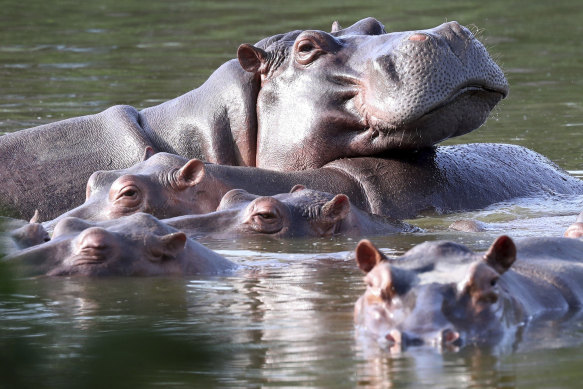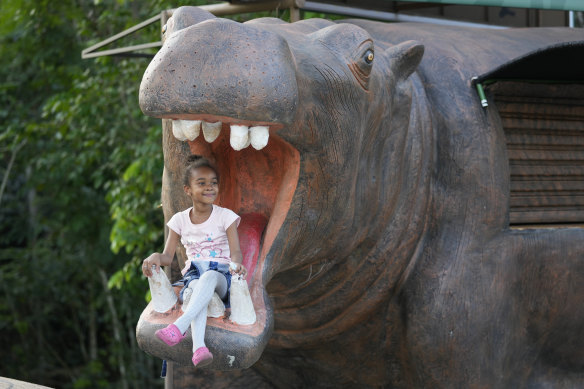Save articles for later
Add articles to your saved list and come back to them any time.
When Colombian drug lord Pablo Escobar was killed in 1993, most of the animals he had imported as pets – zebras, giraffes, kangaroos and rhinoceroses – died or were transferred to zoos.
But not his four hippopotamuses. They thrived. Perhaps a little too well.
Officials estimate that about 170 hippos, descended from Escobar’s original herd, now roam Colombia, and the population could grow to 1000 by 2035, posing a serious threat to the country’s ecosystem.
Hippos float in the lagoon at Hacienda Napoles Park, once the private estate of drug kingpin Pablo Escobar.Credit: AP
This month, after years of debate about what to do with the voracious herbivores, Colombian officials announced a plan to sterilise some, possibly euthanize others and relocate some to sanctuaries in other countries. On Friday, an official said that four hippos — two adult females and two juvenile males — had already been surgically sterilised.
“We are in a race against time in terms of permanent environmental and ecosystem impacts,” Susana Muhamad, Colombia’s environmental minister, said in a statement.
Colombian officials describe the hippos as an aggressive and invasive species with no natural predators.
A girl poses for a photo on a statue of a hippo at the entrance of Hacienda Napoles.Credit: AP
Escobar brought the first four to his lavish estate, Hacienda Nápoles, in the 1980s as part of a wild animal menagerie he used to entertain guests.
After Escobar was killed in a rooftop shootout with security forces in Medellin in 1993, his hippos fended for themselves. They waddled into an artificial pond and reproduced, drawing affection and ire as their numbers multiplied.
A hunting party that included Colombian soldiers, hoping to stop the hippos from spreading beyond Escobar’s estate, shot and killed one named Pepe in 2009. The hunt prompted a public outcry. A judge in Medellin later suspended the hunt for Pepe’s mate and their offspring.
Muhamad blamed 30 years of government inaction for allowing the hippos to multiply far from their native habitat in sub-Saharan Africa. She said that 130 to 150 live in the Magdalena River, Colombia’s principal river.
The government’s goal is to sterilise 40 hippos a year, but sterilising a hippo is not like spaying or neutering a cat.
Hippos can weigh more than 2500kg. Experts said they are generally tranquillised with a dart and undergo surgery wherever they land.
Colombian officials say each sterilisation will cost roughly $US10,000 ($15,300) and will require a team of eight people, including veterinarians, technicians and support staff.
Muhamad said the government was also developing an “ethical euthanasia protocol” but did not say how many hippos might be targeted or by what method.
This article originally appeared in The New York Times.
Get a note directly from our foreign correspondents on what’s making headlines around the world. Sign up for our weekly What in the World newsletter.
Most Viewed in World
From our partners
Source: Read Full Article

